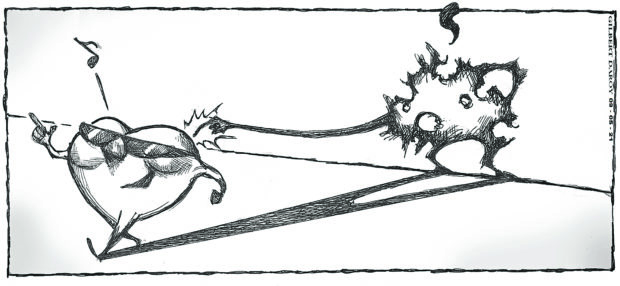The ‘silent killer’

The World Health Organization (WHO) recently issued a warning about a “silent killer” that affects nearly 1.3 billion people globally. It was referring to elevated high blood pressure or hypertension, a serious medical condition that is a major cause of premature death worldwide and can significantly increase the risks of heart, brain, kidney, and other diseases, including COVID-19.
Being health-conscious is even more necessary at this time of pandemic restrictions, when more people can develop hypertension due to being confined to their homes, eating an unhealthy diet, living sedentary lives, and facing heightened mental stress (for many Filipinos, this could be due to the ongoing health crisis, endless government idiocy that only aggravates daily living, or personal circumstances like losing loved ones to the virus or losing jobs, etc.).
But while hypertension can be easily diagnosed by monitoring one’s blood pressure and getting treated with low-cost drugs, half of affected people are unaware of their condition and thus are not treated, according to a joint study by the WHO and the Imperial College London published in The Lancet. The WHO said more than 700 million people worldwide with hypertension are untreated, and that the number of those affected by this condition has doubled to 1.28 billion since 1990. In 2019, almost 18 million people died from cardiovascular diseases, with hypertension identified as a major factor. In addition, more than two-thirds of those with the condition live in low- and middle-income countries.
In the Philippines, data from the Department of Health’s (DOH) 2018 Philippine Health Statistics, the latest on record, show that hypertension was the second leading cause of morbidity in the country, with 637,078 cases and a rate of 602.4 cases per 100,000 population. Per preliminary data from the Philippine Statistics Authority as of last June, it was also the sixth leading cause of mortality, just a notch above COVID-19.
In the last two years, there was a marked increase in deaths caused by hypertensive diseases, from 27,764 in 2019 to 31,610 in 2020. Experts said this could have been due to patients not being able to go for regular checkups because of the lockdowns, or who could no longer afford to go for treatment due to the decreased financial support from government institutions such as the Philippine Charity Sweepstakes Office.
Hypertension is “far from being a condition of affluence, it’s very much a condition of poverty,” said Majid Ezzati, professor of global environmental health at Imperial College London.
Bente Mikkelsen, director of the WHO’s department of noncommunicable diseases, pointed out that aside from genetic risk factors for hypertension, there are “modifiable risk factors” linked to lifestyle, including unhealthy diets, physical inactivity, tobacco and alcohol consumption, uncontrolled diabetes, and being overweight. Obesity, Mikkelsen warned, is “really the tsunami of the risk factors.”
These lifestyle-related risk factors are especially significant and should be looked into in light of a mobile survey conducted by the DOH in January showing that many Filipino adults have developed unhealthy lifestyle habits during the pandemic: About 40 percent said they have turned to alcohol, while 15 percent smoked tobacco.
“On alcohol use, consumption was high, with four in 10 Filipinos (40.1 percent) reporting that they drank alcohol in the 30 days prior to the survey. Alcohol use was higher in men compared to women, with 51.4 percent of men and 28.9 percent of women reporting current drinking use… On tobacco use, the survey revealed that overall, 15.5 percent of Filipino adults are tobacco smokers, with 22.6 percent of men and 8.5 percent of women currently smoking tobacco,” the DOH said in a statement released on Aug. 17. Men reported higher rates of drinking sessions, as well as increased “smokeless tobacco use” (vaping). The survey also showed that 90.1 percent of respondents reported consuming less than the recommended five servings of fruits or vegetables on a daily basis, and there was higher salt intake in diets.
Overall, the DOH said, one in 10 adult Filipinos reported receiving a clinical diagnosis of raised blood sugar or diabetes, while a quarter of adult Filipinos (25.8 percent) reported being told by their doctor that they were hypertensive. More than half or 54.5 percent of those diagnosed with hypertension were on medication to control their condition.
Among the WHO’s recommendations for reducing hypertension are decreased salt intake (to less than 5g daily), eating more fruit and vegetables, regular physical activity, and avoiding tobacco and alcohol. It also said patients must reduce and manage stress, and regularly check blood pressure. For Filipinos, that may mean exercising extra caution when reading or watching the news.




















